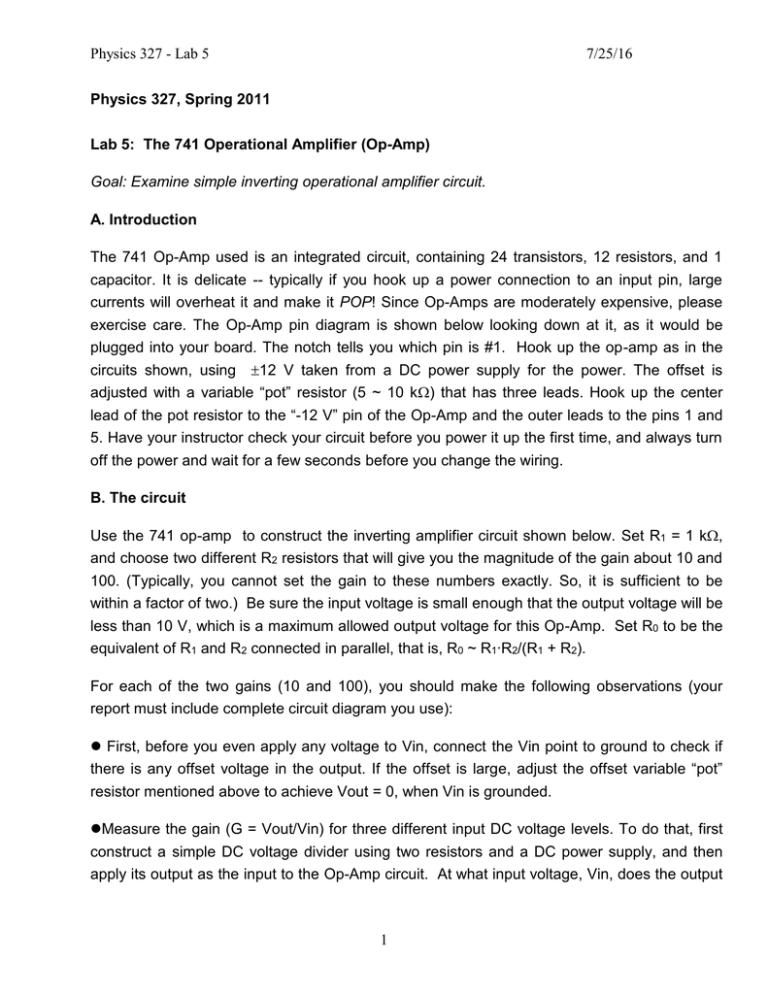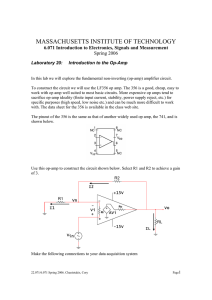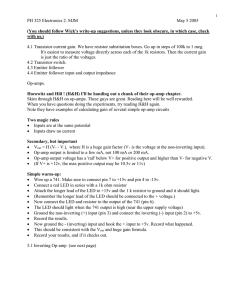Physics 327 - Lab 5 7/25/16 Physics 327, Spring 2011
advertisement

Physics 327 - Lab 5 7/25/16 Physics 327, Spring 2011 Lab 5: The 741 Operational Amplifier (Op-Amp) Goal: Examine simple inverting operational amplifier circuit. A. Introduction The 741 Op-Amp used is an integrated circuit, containing 24 transistors, 12 resistors, and 1 capacitor. It is delicate -- typically if you hook up a power connection to an input pin, large currents will overheat it and make it POP! Since Op-Amps are moderately expensive, please exercise care. The Op-Amp pin diagram is shown below looking down at it, as it would be plugged into your board. The notch tells you which pin is #1. Hook up the op-amp as in the circuits shown, using 12 V taken from a DC power supply for the power. The offset is adjusted with a variable “pot” resistor (5 ~ 10 k) that has three leads. Hook up the center lead of the pot resistor to the “-12 V” pin of the Op-Amp and the outer leads to the pins 1 and 5. Have your instructor check your circuit before you power it up the first time, and always turn off the power and wait for a few seconds before you change the wiring. B. The circuit Use the 741 op-amp to construct the inverting amplifier circuit shown below. Set R1 = 1 k, and choose two different R2 resistors that will give you the magnitude of the gain about 10 and 100. (Typically, you cannot set the gain to these numbers exactly. So, it is sufficient to be within a factor of two.) Be sure the input voltage is small enough that the output voltage will be less than 10 V, which is a maximum allowed output voltage for this Op-Amp. Set R0 to be the equivalent of R1 and R2 connected in parallel, that is, R0 ~ R1∙R2/(R1 + R2). For each of the two gains (10 and 100), you should make the following observations (your report must include complete circuit diagram you use): First, before you even apply any voltage to Vin, connect the Vin point to ground to check if there is any offset voltage in the output. If the offset is large, adjust the offset variable “pot” resistor mentioned above to achieve Vout = 0, when Vin is grounded. Measure the gain (G = Vout/Vin) for three different input DC voltage levels. To do that, first construct a simple DC voltage divider using two resistors and a DC power supply, and then apply its output as the input to the Op-Amp circuit. At what input voltage, Vin, does the output 1 Physics 327 - Lab 5 7/25/16 voltage, Vout, of the Op-Amp saturate to a maximum of ~ 10V? Use the simple gain equation of the Op-Amp (Vout = G∙Vin) to figure out what resistors you have to choose for your DC voltage divider to get the right Vin that would result in Vout < 10V. Use either the oscilloscope or digital voltmeter (DVM) to measure the output voltage on your Op-Amp for each Vin. Document the measurements as a Table in your report containing the values of R1, R2, Vin, Vout and the gain G. Now, disconnect the voltage divider (at the power to the Op-Amp turned off), and use the function generator to input a sine wave to the Op-Amp - make sure the input averages to 0 by looking at the input with DC coupling on the oscilloscope - and measure the gain and phase shift with the oscilloscope for a gain of 100 by observing both Vin and Vout sinusoidal traces at the oscilloscope display and measuring their amplitudes and a phase shift. In this part, you can not use DVM for your measurements, because you are using fairly high frequency signals. You may need to decrease the input amplitude to maintain the output in sinusoidal waveform. Also, please select the frequency of the input sine wave in the range that gives you the expected gain: G of the Op-Amp is fairly constant up to a certain pretty high frequency, however it falls off at much higher frequencies. Record both input and output amplitudes, the phase shift and evaluate the gain. Note: The power supply (±12V) and the variable pot resistor are not shown on this circuit diagram, yet they need to be connected to your Op-Amp circuit to operate properly. Remember to always turn off the power and wait for a few seconds each time before you change the wiring. 2







